air condition RENAULT KANGOO 2018 User Guide
[x] Cancel search | Manufacturer: RENAULT, Model Year: 2018, Model line: KANGOO, Model: RENAULT KANGOO 2018Pages: 264, PDF Size: 7.09 MB
Page 147 of 264

3.11
AUTOMATIC CLIMATE CONTROL (5/8)
In automatic mode, depending on
the outside air conditions, the ven-
tilation may not start immediately at
maximum power but will increase
progressively until the engine tem-
perature is warm enough to heat the
passenger compartment air. This
may take from a few seconds to se-
veral minutes.
Varying the ventilation speed
In automatic mode, the system uses
the most suitable amount of air to reach
and maintain the desired comfort level.
Automatic mode is switched off by pres-
sing buttons 8 and 10.
These buttons allow you to increase or
decrease ventilation speed.
Switching air conditioning on
or off
In automatic mode, the system switches
the air conditioning system on or off,
depending on the climate conditions.
Exit automatic mode by pressing
button 2: the AUTO warning light on
display 4 goes out. Note: the “Clear View” function auto-
matically activates the air conditioning.
Press button
5 to return to automatic
mode.
4
8
10
25
Page 149 of 264

3.13
Note: if you wish to reduce the air flow
(which may produce a certain amount
of noise in the passenger compart-
ment), press button 10.
To exit this function , press:
– button 1 again;
– or button 5 (the AUTO indicator light
on the display will light up).
Clear View function
Press button 1.
The AUTO button indicator light (on the
display) goes out.
AUTOMATIC CLIMATE CONTROL (7/8)
This function rapidly demists/de-ices
the windscreen, the front side windows
and the door mirrors.
It imposes automatic operation of the
air conditioning and rear screen de-
icing, and inhibits air recirculation.
Press button 11 if you do not want the
heated rear screen to be activated.
1
10
5
11
Page 151 of 264
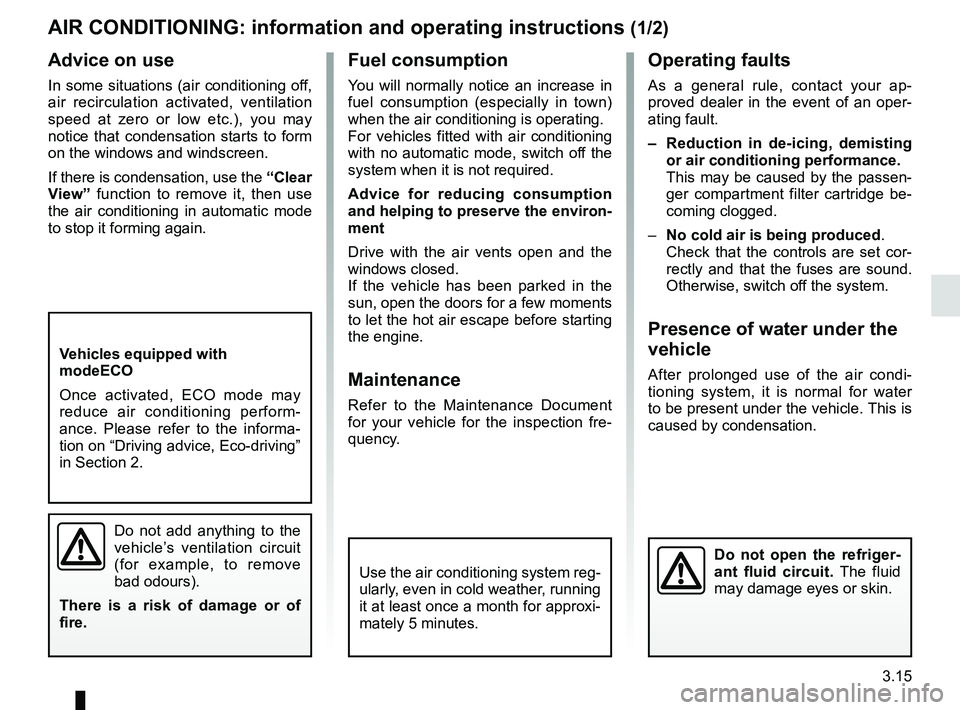
3.15
Operating faults
As a general rule, contact your ap-
proved dealer in the event of an oper-
ating fault.
– Reduction in de-icing, demisting or air conditioning performance.
This may be caused by the passen-
ger compartment filter cartridge be-
coming clogged.
– No cold air is being produced .
Check that the controls are set cor-
rectly and that the fuses are sound.
Otherwise, switch off the system.
Presence of water under the
vehicle
After prolonged use of the air condi-
tioning system, it is normal for water
to be present under the vehicle. This is
caused by condensation.
AIR CONDITIONING: information and operating instructions (1/2)
Do not open the refriger-
ant fluid circuit. The fluid
may damage eyes or skin.
Fuel consumption
You will normally notice an increase in
fuel consumption (especially in town)
when the air conditioning is operating.
For vehicles fitted with air conditioning
with no automatic mode, switch off the
system when it is not required.
Advice for reducing consumption
and helping to preserve the environ-
ment
Drive with the air vents open and the
windows closed.
If the vehicle has been parked in the
sun, open the doors for a few moments
to let the hot air escape before starting
the engine.
Maintenance
Refer to the Maintenance Document
for your vehicle for the inspection fre-
quency.
Advice on use
In some situations (air conditioning off,
air recirculation activated, ventilation
speed at zero or low etc.), you may
notice that condensation starts to form
on the windows and windscreen.
If there is condensation, use the “Clear
View” function to remove it, then use
the air conditioning in automatic mode
to stop it forming again.
Do not add anything to the
vehicle’s ventilation circuit
(for example, to remove
bad odours).
There is a risk of damage or of
fire.
Use the air conditioning system reg-
ularly, even in cold weather, running
it at least once a month for approxi-
mately 5 minutes.
Vehicles equipped with
modeECO
Once activated, ECO mode may
reduce air conditioning perform-
ance. Please refer to the informa-
tion on “Driving advice, Eco-driving”
in Section 2.
Page 152 of 264
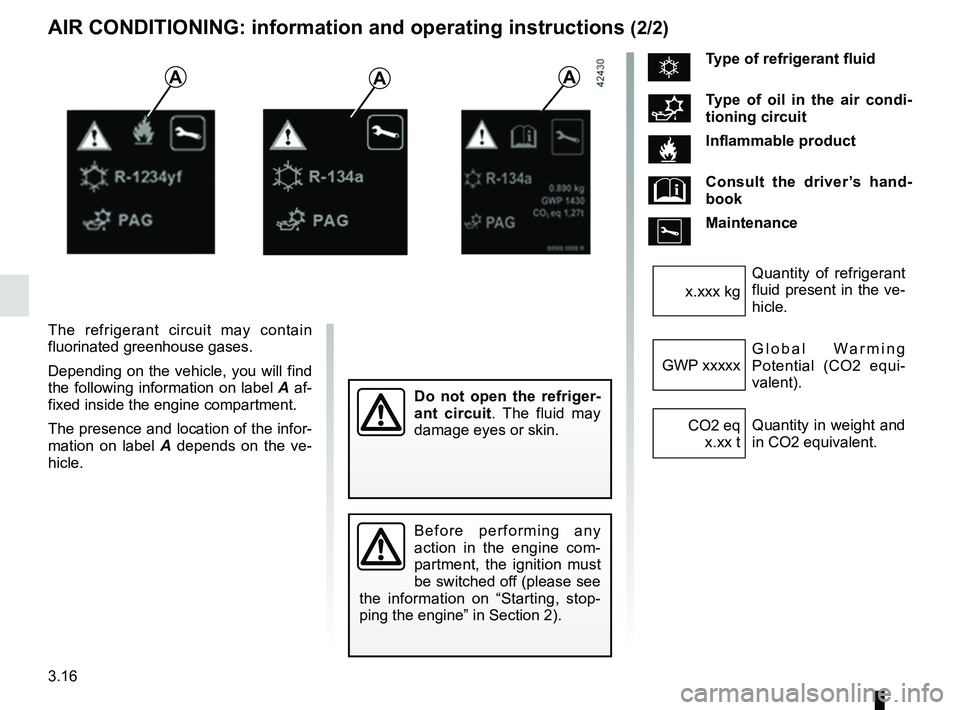
3.16
AIR CONDITIONING: information and operating instructions (2/2)
The refrigerant circuit may contain
fluorinated greenhouse gases.
Depending on the vehicle, you will find
the following information on label A af-
fixed inside the engine compartment.
The presence and location of the infor-
mation on label A depends on the ve-
hicle.
AAA
Do not open the refriger-
ant circuit . The fluid may
damage eyes or skin.
Before performing any
action in the engine com-
partment, the ignition must
be switched off (please see
the information on “Starting, stop-
ping the engine” in Section 2).
ÑType of refrigerant fluid
Type of oil in the air condi-
tioning circuit
Inflammable product
Consult the driver’s hand-
book
Maintenance
Quantity of refrigerant
fluid present in the ve-
hicle.
x.xxx kg
Global Warming
Potential (CO2 equi-
valent).
GWP xxxxx
Quantity in weight and
in CO2 equivalent.
CO2 eq
x.xx t
Page 198 of 264
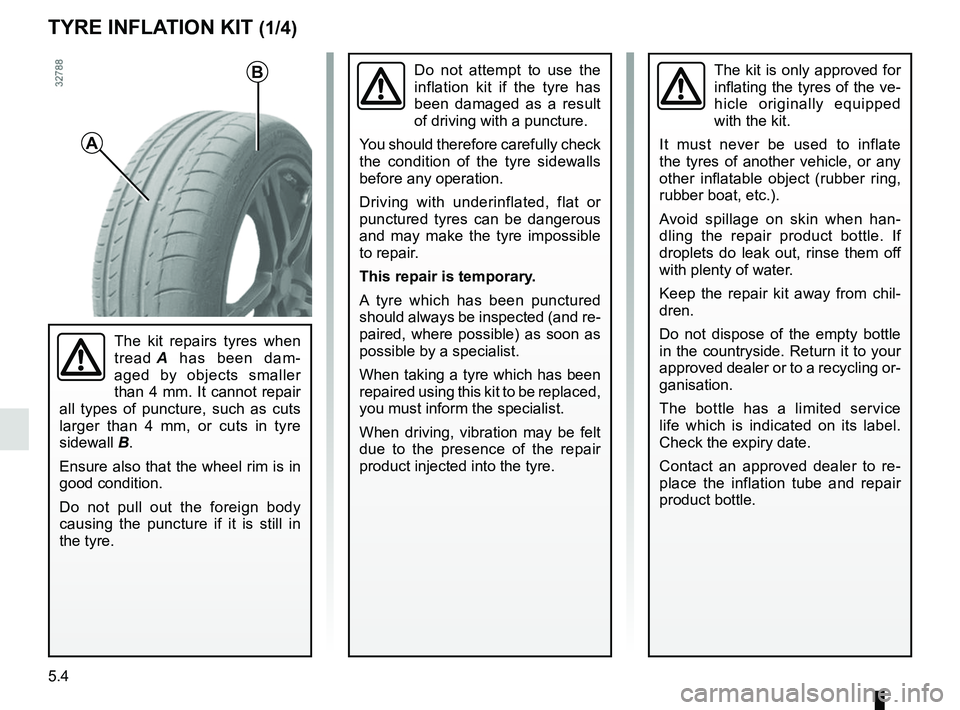
5.4
TYRE INFLATION KIT (1/4)
The kit repairs tyres when
tread A has been dam-
aged by objects smaller
than 4 mm. It cannot repair
all types of puncture, such as cuts
larger than 4 mm, or cuts in tyre
sidewall B.
Ensure also that the wheel rim is in
good condition.
Do not pull out the foreign body
causing the puncture if it is still in
the tyre.
Do not attempt to use the
inflation kit if the tyre has
been damaged as a result
of driving with a puncture.
You should therefore carefully check
the condition of the tyre sidewalls
before any operation.
Driving with underinflated, flat or
punctured tyres can be dangerous
and may make the tyre impossible
to repair.
This repair is temporary.
A tyre which has been punctured
should always be inspected (and re-
paired, where possible) as soon as
possible by a specialist.
When taking a tyre which has been
repaired using this kit to be replaced,
you must inform the specialist.
When driving, vibration may be felt
due to the presence of the repair
product injected into the tyre.The kit is only approved for
inflating the tyres of the ve-
hicle originally equipped
with the kit.
It must never be used to inflate
the tyres of another vehicle, or any
other inflatable object (rubber ring,
rubber boat, etc.).
Avoid spillage on skin when han-
dling the repair product bottle. If
droplets do leak out, rinse them off
with plenty of water.
Keep the repair kit away from chil-
dren.
Do not dispose of the empty bottle
in the countryside. Return it to your
approved dealer or to a recycling or-
ganisation.
The bottle has a limited service
life which is indicated on its label.
Check the expiry date.
Contact an approved dealer to re-
place the inflation tube and repair
product bottle.
A
B
Page 222 of 264

5.28
FUSES (2/2)
Number Allocation
1 Fuel pump
2 Not used
3 Passenger compartment
engine cooling fan
4 Passenger compartment
engine cooling fan
5 Rear windscreen wiper
6 Horn, diagnostic socket
7 Heated seats
8 Electric rear windows
9 Passenger compartment
ECU
10 Windscreen washer
11 Brake lights
12 Passenger compartment
unit, ABS, ESP
13 Electric windows, child
safety, heating and air
conditioning system, ECO
mode
14 Not used
15 StarterNumber Allocation
16 Brake lights, additional
equipment, navigation,
ABS, ESP, boot light, tyre
pressure warning light,
interior lights, rain and light
sensor
17 Radio, navigation system,
display, alarm
18 Additional equipment
19 Heated door mirrors
20 Hazard lights, rear fog lights
21 Central locking of opening
elements
22 Instrument panel
23 Rear accessories socket
24 ESC, radio, heating and air
conditioning system, heated
seats, stop lights
25 Front accessories socket
26 Towbar
27 Electric front windows
28 Rear-view mirror control
29 De-icing the rear screen and
rear view mirror
12
3456
78910
11121314
15161718
19202122
23242526
27
28
29
Allocation of fusesThe presence of certain fuses de-
pends on the vehicle equipment
level.
Page 245 of 264
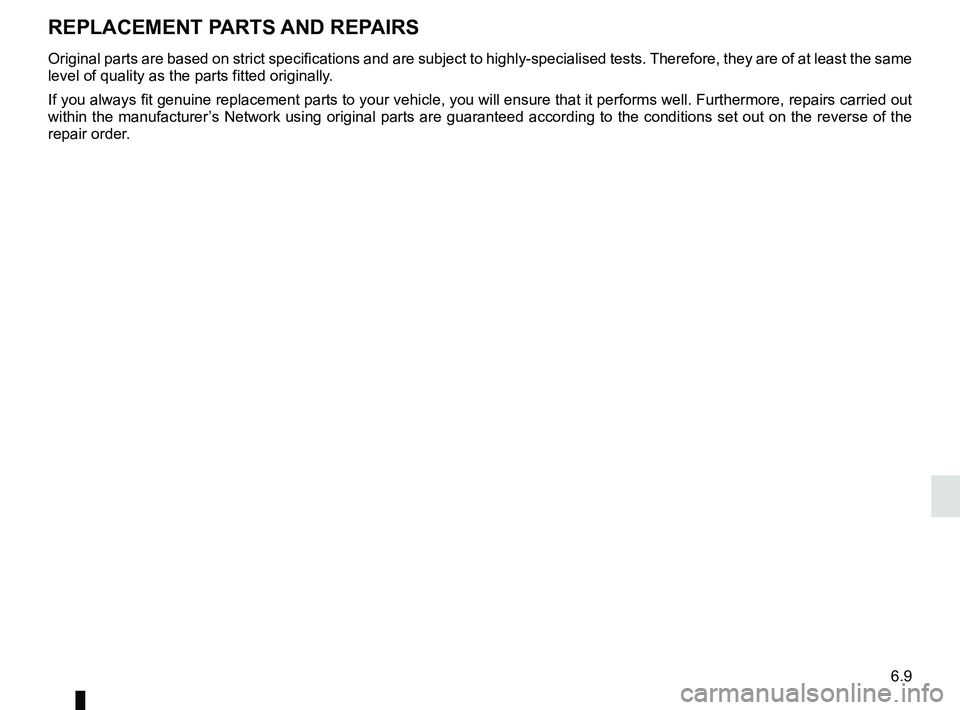
6.9
Original parts are based on strict specifications and are subject to hig\
hly-specialised tests. Therefore, they are of at least the same
level of quality as the parts fitted originally.
If you always fit genuine replacement parts to your vehicle, you will en\
sure that it performs well. Furthermore, repairs carried out
within the manufacturer’s Network using original parts are guaranteed according to the condition\
s set out on the reverse of the
repair order.
REPLACEMENT PARTS AND REPAIRS
Page 257 of 264
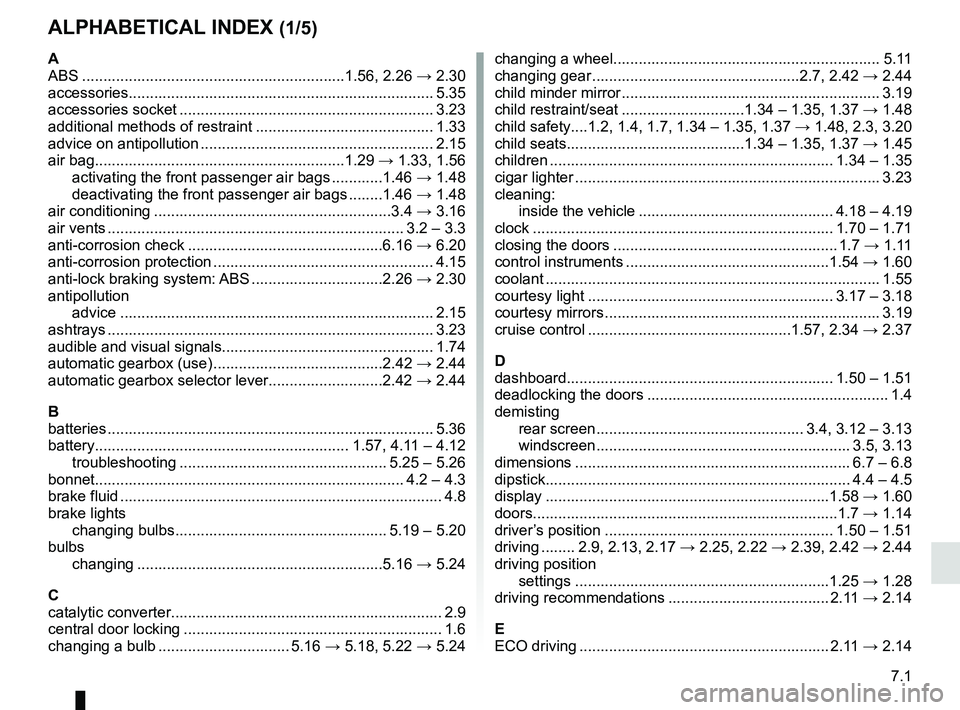
7.1
ALPHABETICAL INDEX (1/5)
A
ABS ..............................................................1.56, 2.26 → 2.30
accessories........................................................................\
5.35
accessories socket ............................................................ 3.23
additional methods of restraint .......................................... 1.33
advice on antipollution ....................................................... 2.15
air bag...........................................................1.29 → 1.33, 1.56
activating the front passenger air bags ............1.46 → 1.48
deactivating the front passenger air bags ........1.46 → 1.48
air conditioning ........................................................3.4 → 3.16
air vents ...................................................................... 3.2 – 3.3
anti-corrosion check ..............................................6.16 → 6.20
anti-corrosion protection .................................................... 4.15
anti-lock braking system: ABS ...............................2.26 → 2.30
antipollution advice .................................................................\
......... 2.15
ashtrays ...............................................................\
.............. 3.23
audible and visual signals.................................................. 1.74
automatic gearbox (use) ........................................2.42 → 2.44
automatic gearbox selector lever...........................2.42 → 2.44
B
batteries ..............................................................\
............... 5.36
battery............................................................ 1.57, 4.11 – 4.12 troubleshooting ................................................. 5.25 – 5.26
bonnet........................................................................\
. 4.2 – 4.3
brake fluid ........................................................................\
.... 4.8
brake lights changing bulbs .................................................. 5.19 – 5.20
bulbs changing ..........................................................5.16 → 5.24
C
catalytic converter................................................................ 2.9
central door locking ............................................................. 1.6
changing a bulb ............................... 5.16 → 5.18, 5.22 → 5.24changing a wheel............................................................... 5.11
changing gear .................................................2.7, 2.42 → 2.44
child minder mirror ............................................................. 3.19
child restraint/seat .............................1.34 – 1.35, 1.37 → 1.48
child safety....1.2, 1.4, 1.7, 1.34 – 1.35, 1.37 → 1.48, 2.3, 3.20
child seats..........................................1.34 – 1.35, 1.37 → 1.45
children ................................................................... 1.34 – 1.35
cigar lighter ........................................................................\
3.23
cleaning: inside the vehicle .............................................. 4.18 – 4.19
clock ....................................................................... 1.70 – 1.71
closing the doors ..................................................... 1.7 → 1.11
control instruments ................................................1.54 → 1.60
coolant ................................................................\
............... 1.55
courtesy light .......................................................... 3.17 – 3.18
courtesy mirrors ................................................................. 3.19
cruise control ................................................1.57, 2.34 → 2.37
D
dashboard............................................................... 1.50 – 1.51
deadlocking the doors ......................................................... 1.4
demisting rear screen ................................................. 3.4, 3.12 – 3.13
windscreen ............................................................ 3.5, 3.13
dimensions ................................................................. 6.7 – 6.8
dipstick................................................................\
........ 4.4 – 4.5
display ................................................................\
...1.58 → 1.60
doors........................................................................\
1.7 → 1.14
driver’s position ...................................................... 1.50 – 1.51
driving ........ 2.9, 2.13, 2.17 → 2.25, 2.22 → 2.39, 2.42 → 2.44
driving position settings ............................................................1.25 → 1.28
driving recommendations ...................................... 2.11 → 2.14
E
ECO driving ........................................................... 2.11 → 2.14
Page 258 of 264

7.2
ALPHABETICAL INDEX (2/5)
ECO mode ........................................................................\
. 2.12
electric windows ..................................................... 3.20 – 3.21
electronic stability control: ESC .............................2.26 → 2.30
emergency brake assist.........................................2.26 → 2.30
emergency braking ................................................2.26 → 2.30
emergency spare wheel ...................................................... 5.2
engine technical specifications ......................................... 6.4 – 6.5
engine coolant ..................................................................... 4.9
engine oil ..........................................................1.56, 4.4 → 4.7
engine oil capacity ...................................................... 4.6 – 4.7
engine oil level ...........................................................4.4 → 4.7
engine specifications .................................................. 6.4 – 6.5
environment ............................................................\
........... 2.16
ESC: electronic stability control ....................1.57, 2.26 → 2.30
external temperature .............................................. 1.70 – 1.71
F
faults operating faults ................................................5.37 → 5.42
filter .................................................................\
................... 4.10
fitting a radio ........................................................... 5.33 – 5.34
fittings ...............................................................\
.....3.24 → 3.28
fog lights ................................................................... 1.77, 5.18
front lights changing bulbs .................................................. 5.16 – 5.17
front passenger air bag deactivation .....................1.46 → 1.48
front seat adjustment .............................................1.19 → 1.21
front seats adjustment .......................................................1.19 → 1.21
fuel advice on fuel economy ................................... 2.11 → 2.14
capacity ...............................................................\
......... 1.83
consumption .................................................... 2.11 → 2.14
filling ........................................................1.56, 1.83 → 1.85
grade ..................................................................\
.......... 1.83 fuel consumption ................................................... 2.11
→ 2.14
fuel filler cap ..........................................................1.83 → 1.85
fuel tank capacity ............................................................1.83 → 1.85
fuel tank capacity ...................................................1.83 → 1.85
fuses ....................................................................... 5.27 – 5.28
G
gear lever........................................................................\
..... 2.7
glove box ........................................................................\
... 3.24
grip control ........................................................................\
. 2.29
H
handbrake................................................................... 1.55, 2.8
hazard warning lights signal .............................................. 1.74
headlight beam adjustment .................................... 1.78 – 1.79
headrest.................................................................1.15 → 1.18
heated seats ..........................................................1.19 → 1.21
heating and air conditioning system ........................3.4 → 3.15
heating system ........................................................3.4 → 3.16
horn ...................................................................\
................ 1.74
horn: flash ..................................................................\
........... 1.74
sounding the horn ........................................................ 1.74
hubcap tool ........................................................................\
.. 5.8
I
ignition switch ...................................................................... 2.2
indicators ................................................ 1.54, 1.74, 5.17, 5.22
indicators: direction indicators .............................................. 5.17, 5.22
instrument panel ..............................................1.58 → 1.60
instrument panel ....................................................1.54 → 1.69
instrument panel messages...................................1.61 → 1.69
interior lighting: changing bulbs .................................................. 5.23 – 5.24